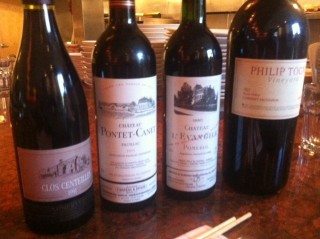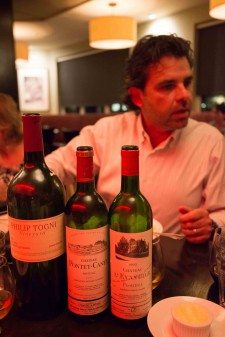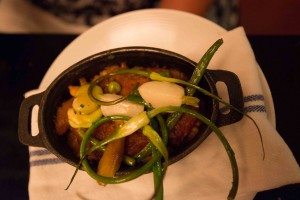Bordeaux improves through cellaring; nothing new about that. A long time ago I joined a group dinner to taste claret with Clive Coates and he drew something like this to explain a cultural gap in patience, along wines’ life trajectories, between British and American wine enthusiasts:
 At a very recent dinner I hosted for a group of business friends at AKA Bistro in Lincoln, MA (the only place to really dine well in the Boston suburbs) I was reminded of (1) Coates’ impromptu hand drawing and (2) the style of wine that is inarguably my favorite to drink. Wine that holds its balance while turning graceful through patient cellaring, sheds tough tannins that tame and integrate with varietal fruit flavors and aromatics, adds compatible secondary flavor/aromatic notes in symphonic fashion, is created from Cabernet Sauvignon, Merlot, Petit Verdot, Malbec, and/or Cabernet Franc, and is usually from Bordeaux live at the center of my most memorable drinking experiences. I have consistently proven this out over more than a quarter century of wine enthusiasm. While there are legitimately better wines on earth for others, these live at the center of my personal pleasure zone.
At a very recent dinner I hosted for a group of business friends at AKA Bistro in Lincoln, MA (the only place to really dine well in the Boston suburbs) I was reminded of (1) Coates’ impromptu hand drawing and (2) the style of wine that is inarguably my favorite to drink. Wine that holds its balance while turning graceful through patient cellaring, sheds tough tannins that tame and integrate with varietal fruit flavors and aromatics, adds compatible secondary flavor/aromatic notes in symphonic fashion, is created from Cabernet Sauvignon, Merlot, Petit Verdot, Malbec, and/or Cabernet Franc, and is usually from Bordeaux live at the center of my most memorable drinking experiences. I have consistently proven this out over more than a quarter century of wine enthusiasm. While there are legitimately better wines on earth for others, these live at the center of my personal pleasure zone.
There is speculative wisdom about why Americans do not age wines up to and beyond their point of maturity, but let’s not go there. With certainty, I figured out why I launched and stuck to a regimen for laying down Bordeaux. Besides my palate’s compatibility with this previously described style, I now understand that I enjoy playing some role in the final product’s outcome; especially since it improves upon the foundation work of the winemaker. There is great reward in knowing the wine I bought from the producer benefitted from my own action or, better yet, patient inaction. As importantly, it seems silly to finance someone else’s cellar space by buying these wines at the appreciated price points mature wines fetch at auction and other secondary markets.
 On this evening at AKA Bistro, while seven of us indulged in a recommended and fascinating Californian **** 2010 Donkey and Goat Stone Crusher Rousanne and a very complete and aged 1991 ***1/2 Clos Centeilles Minervois from the Languedoc, the highlights of the evening were a magnum of **** 1993 Philip Togni Cabernet Sauvignon from Napa Valley, the ****1/2 1995 Pontet Canet from Paulliac and a mind blowing ***** 1990 L’Evangile from Pomerol.
On this evening at AKA Bistro, while seven of us indulged in a recommended and fascinating Californian **** 2010 Donkey and Goat Stone Crusher Rousanne and a very complete and aged 1991 ***1/2 Clos Centeilles Minervois from the Languedoc, the highlights of the evening were a magnum of **** 1993 Philip Togni Cabernet Sauvignon from Napa Valley, the ****1/2 1995 Pontet Canet from Paulliac and a mind blowing ***** 1990 L’Evangile from Pomerol.
There were distinct differences between the wines, and tasting them side by side was telling. The Californian Togni, even in magnum, was at it’s peak and completely ready to drink. It showed full-on secondary aromas with tobacco dominating. The balance was still evident but the wine, compared to the Bordeaux, was more tired. Beautiful for sure, but less vibrant and lacking the lasting acidity and nuance fruit and spice flavors that make the Bordeaux more exhilarating.
The Cabernet Sauvignon dominant Pontet-Canet was brawnier, as expected, than the Pomerol. But the wine proudly showed the very same profile flavors and aromas it boasted when it was younger. It is pacing itself through its own life cycle to maintain identity and balance; stepping down the intensity scale to a place that you can appreciate its uniquely characteristic dark fruit, cedar, and earth without full-on tannins and that big, ripe fruit birthmark. A bruiser turning charming, wafting over your tongue and down your throat with elegant power at 17 years of age. Magic.
The 22-year-old right bank Merlot/Cabernet Franc L’Evangile had dominant fennel and mocha to go with its elegant pure fruit. The wine is totally graceful, yet offers lively acidity and moderated tannins to keep it exciting. While the component flavors have melted together in seamless fashion, there is clear evidence that it will continue to live a long life and most likely develop even more interesting and intense secondary aromas and flavors well beyond its point of maturity. For me this wine is perfect, but it will cost someone $275-$375 to buy a bottle now, and probably $750 in a restaurant. I paid closer to $50 for it in the early ’90s.
Laying down Bordeaux seems so prudent and forward thinking. Why don’t more American wine drinkers jump on the bandwagon? It’s perplexing that so few wine consumers get invested in drinking these beautiful wines alongside the high levels of food like we enjoyed at AKA Bistro:
Note: Thanks to Mally Skok for the dinner idea, David Skok for the photos and Leslie and David Fine and Lynda Simonton for filling out the great company and reason for my wonderful wife and I to pull these wines from our cellar.




